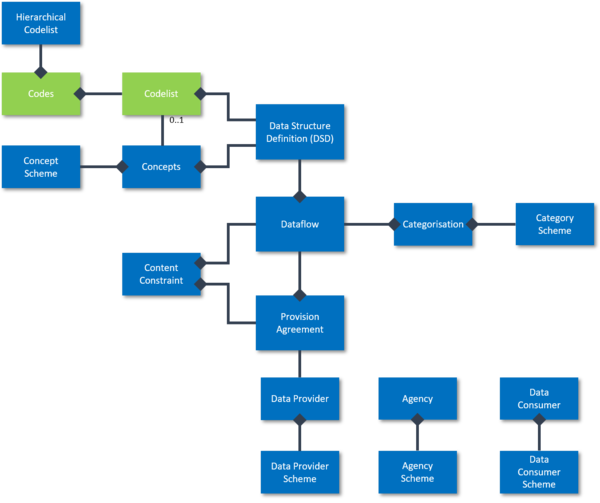Difference between revisions of "Codelist V10"
(→Properties) |
(→Properties) |
||
| Line 4: | Line 4: | ||
An SDMX Codelist is a managed list of classification codes. | An SDMX Codelist is a managed list of classification codes. | ||
| − | ==Properties== | + | ==Structure Properties== |
{| class="wikitable" | {| class="wikitable" | ||
! scope=row style="text-align: left;" | Structure Type | ! scope=row style="text-align: left;" | Structure Type | ||
Revision as of 03:05, 19 December 2019
Contents
Overview
An SDMX Codelist is a managed list of classification codes.
Structure Properties
| Structure Type | Standard SDMX Structural Metadata Artefact |
|---|---|
| Maintainable | Yes |
| Identifiable | Yes |
| Item Scheme | Yes |
| SDMX Information Model Versions | 1.0, 2.0, 2.1 |
| Concept ID | CODELIST |
Codelists Context within the SDMX 2.1 Information Model
The schematic illustrates the core artefacts of the SDMX 2.1 Information Model, and how Codelists and Codes fit in.
Codelists can be referenced directly by Data Structure Definitions (DSD), or indirectly through Concepts to explictly define the set of legal values for enumerated Dimensions or Attributes.
Usage
SDMX Codelists are lists of classification codes used principally for defining the set of allowed values for enumerated Components in Data Structure Definitions (DSDs) or Metadata Structure Definitions which describe Reference Metadata.
Each code is a separate Item so must have an ID and a Name, but can also have an optional Description. While Code IDs must be unique within a Codelist, the same Code ID may be safely used in other Codelists. For instance: The code 'A' may be used in a Frequency Codelist to represent 'Annual', but also appear in an Industry Codelist to represent 'Agriculture'.
Flat Codelists
Flat Codelists are simple lists of codes with no explicit or implied relationships or hierarchies.
Example: CL_FREQUENCY Codelist
| Code ID | Code Name |
|---|---|
| A | Annual |
| S | Half-yearly, semester |
| Q | Quarterly |
| M | Monthly |
| W | Weekly |
| D | Daily |
| B | Daily - Business Week |
| N | Minutely |
Codelists with Simple Hierarchies
SDMX allows simple hierarchies to be defined within flat Codelists by making a code the parent of codes that logically sit under it in the hierarchy.
Imagine a CL_REF_AREA Codelist containing individual codes for each European country, and a code (EUR) for Europe as a whole. A simple hierarchy for Europe can be created by setting EUR as the parent for each of the countries:
| Code ID | Code Name | Parent |
|---|---|---|
| EUR | Europe | (none) |
| DE | Germany | EUR |
| FR | France | EUR |
| IT | Italy | EUR |
| GR | Greece | EUR |
| SE | Sweden | EUR |
| AU | Austria | EUR |
| PL | Poland | EUR |
Other than acting as a parent, EUR behaves as a normal code allowing series for EUR or any of the individual contries.
A Code can only have one parent meaning that it can only appear once in a simple Codelist hierarchy. This may be restrictive where Codes can be logically organised into multiple different groups. In the CL_REF_AREA example, countries could also be grouped into trading blocs in addition to geographical regions.
SDMX Hierarchical Codelists should be used where Codelists have more complex hierarchical structures.
Hierarchical Codelists
SDMX Hierarchical Codelists are separately maintainable artefacts used to describe complex Code hierarchies.
Conventions
'CL_' Codelist ID Prefix
Codelist IDs are given a 'CL_' prefix to distinguish them from other structures. For instance: CL_FREQ, CL_REF_AREA, CL_AGE.
Code ID Conventions
Codes can take any legal SDMX ID. But there are several conventions that should be taken into account when choosing Code IDs:
| Uppercase Code IDs | By convention, Code ID's are in uppercase such as 'ABC'. Lower case Codes are valid (for example 'abc'), but care should be taken in their use to avoid confusion. |
| '_Z' Code | The '_Z' code is conventionally used for the Undefined and Unknown classification. |
| 'TOTAL' Code | The 'TOTAL' code represents the total or sum of the dimension. For a 'country' dimension, series with TOTAL would indicate the sum of observation values for all countries. |
Examples
Simple Flat Codelist
| Code ID | Code Name |
|---|---|
| A | Annual |
| S | Half-yearly, semester |
| Q | Quarterly |
| M | Monthly |
| W | Weekly |
| D | Daily |
| B | Daily - Business Week |
| N | Minutely |
Flat Codelist with Optional Code Descriptions
| Code ID | Code Name | Code Description |
|---|---|---|
| K | Calendar component | Synonyms: Calendar effects; calendar factors |
| X | Seasonal component | Synonyms: Seasonal effects; seasonal factors |
| M | Seasonal and calendar components | Synonyms: Seasonal and calendar effects; seasonal and calendar factors |
| I | Irregular component | Synonym: Irregular effects |
| N | Neither seasonally adjusted nor calendar adjusted data | Synonyms: Raw data; unadjusted data |
